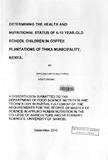| dc.description.abstract | The physical growth of school children aged 6-10 years, is the result of both
environment and genetic factors and the interaction between the two. In poor
populations the main factors affecting the physical growth of school age children
are the environmental factors experienced before puberty .Malnutrition among the
school age child is as a result of poor food consumption patterns, illness, poor
sanitation and poor health and hygiene practices. Studies show that malnutrition is
implicated in more than half of all child deaths world wide. Millions of survivors are
left crippled, vulnerable to illness and intellectually disabled .It imperils women,
families, and ultimately, the viability of whole societies. Child malnutrition is
observed in school age children of low income populations in plantations.
The objective of this study was to determine the health and nutritional status of
school age children in coffee plantations, and to achieve this a cross sectional
study was carried out in Thika municipality, Thika district, Kenya. The sample size
was 280 house holds in the community with school age children (6-10 years) as
the target group and care takers as respondents. A structured pre-tested
questionnaire was used to gather all the needed information. In the study,
anthropometric indices (Z-Scores) were used to determine the nutritional status of
the children. The information gathered using the structured questionnaire
included: Demographic characteristics of the household, socioeconomic factors of
the house holds, sanitation factors and house hold food frequency and information
about the index child.
Simple descriptive statistics, chi-square test and correlation analysis were
used to analyse the data with a p<0.05 being statistically significant. Data was
entered, cleaned and analysed using SPSS and Epi-info (version 6) software.
There are significant relationships between underweight and source of income
being significant at p value<0.05.The tests also showed that there were
significant differences in family size, type of toilet and stunting
(p<0.05).Correlation showed that there were significant differences between
sex and all three forms of malnutrition the relationship being significant at p
value<0.05. The correlation analysis also showed significant relationships
between wasting, underweight, stunting and other variables (household head,
source of income family size, disease, etc) the relationship being significant at
p<0.05. The study showed that 17% of the study children were below -2SD
with 20% of the boys being below -2SD while 14.2% of the girls being below -
2SD.
The study concluded that the school age child's nutritional status was
influenced by access and availability of food, income and morbidity. Wasting
and stunting were the most common forms of malnutrition among children
aged 6-10 years in the coffee plantations. The study found that school age
children are a vulnerable group to malnutrition and quick action need to be
taken by all the stakeholders to improve their nutritional status. It is
recommended that active growth monitoring of the school children to be
implemented as it is an easy and inexpensive tool for health professionals to
obtain information on the health and nutritional status school age population. | en |

